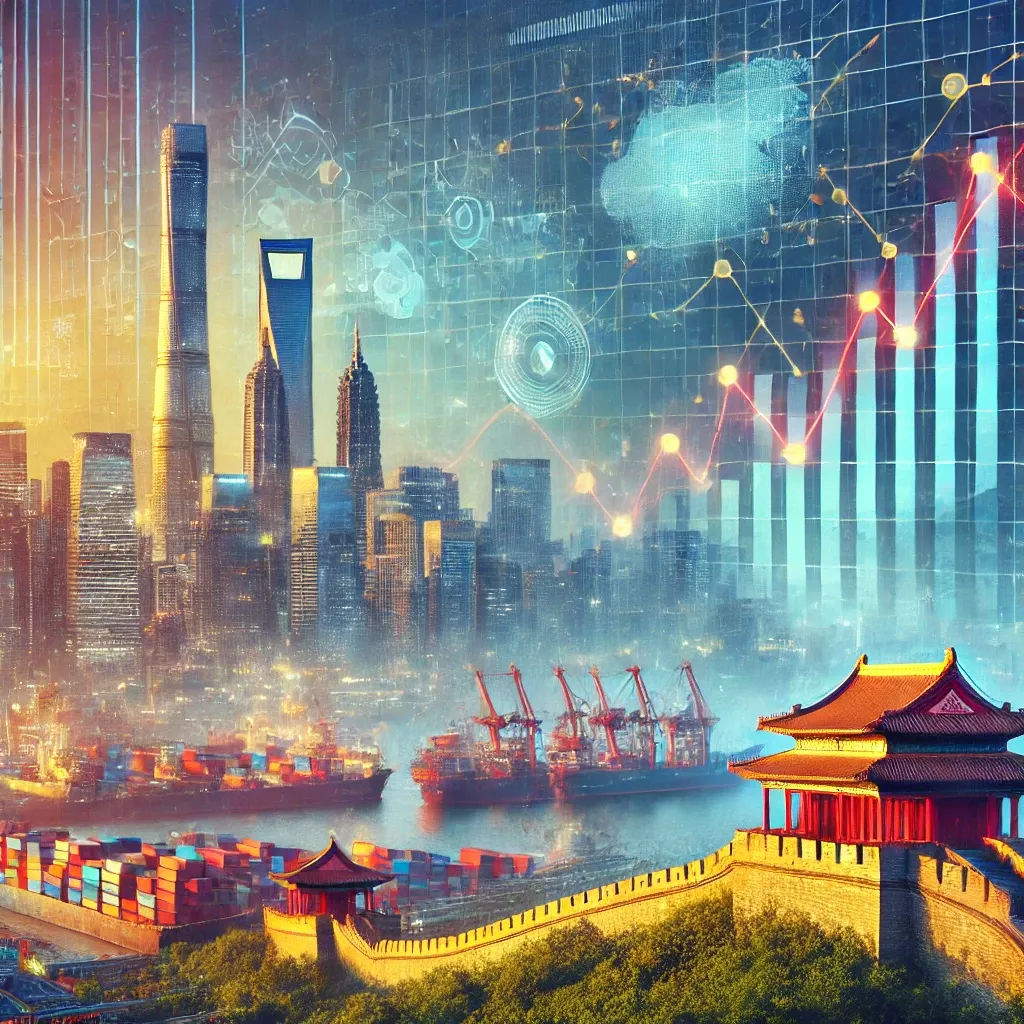Economic Report China
China, the world’s second-largest economy, has undergone rapid growth over the past four decades, transforming from an agrarian society into a global manufacturing and technology hub.

Introduction
China, the world’s second-largest economy, has undergone rapid growth over the past four decades, transforming from an agrarian society into a global manufacturing and technology hub. However, as China transitions to a more consumer-driven economy, it faces significant challenges, including demographic decline, rising debt, energy dependency, and innovation gaps. This report explores these issues through key factors such as labour dynamics, migration, energy, and innovation.
Key Findings
1. Economic Performance
- China is the second-largest economy globally and the largest in terms of purchasing power parity (PPP).
- GDP growth has slowed from double digits in previous decades to approximately 3–5% in recent years.
- The economy is shifting from an export-driven model to one focused on domestic consumption and high-tech industries.
2. Labour Force and Demographics
- China's population has begun shrinking, with the birth rate falling below replacement levels.
- The working-age population (15–64) is declining, creating labour shortages and increasing pressure on social support systems.
- The hukou system (household registration) restricts rural workers from fully integrating into urban economies, limiting mobility and productivity.
3. Migration Dynamics
- Internal migration has driven urbanization, with over 200 million rural workers moving to cities for better opportunities.
- Emigration of highly skilled professionals (the "brain drain") poses challenges, as many seek opportunities in the USA, Canada, and Europe.
- Policies to attract foreign talent and reverse brain drain have had limited success due to cultural, political, and economic barriers.
4. Energy and Infrastructure
- China is the largest consumer and producer of coal, relying on it for over 50% of its energy needs.
- Investments in renewable energy are unparalleled, with China leading in solar, wind, and hydroelectric power production.
- Despite rapid infrastructure development, overinvestment in poorly planned projects has created "ghost cities" and high local government debt.
5. Innovation and Technology
- China has made significant strides in high-tech industries, such as AI, 5G, and electric vehicles, but still relies on foreign technology for advanced semiconductors and aerospace.
- State-led initiatives like "Made in China 2025" aim to reduce dependency on imports and establish global leadership in key sectors.
- The tech sector faces increasing scrutiny and regulation, stifling some entrepreneurial activity.
6. Social and Economic Disparities
- Regional inequality persists, with coastal provinces thriving while inland and rural areas lag.
- Income inequality is rising, despite efforts to promote "common prosperity."
- Social services, including healthcare and pensions, are underfunded relative to the aging population’s needs.
Key Areas of Focus
1. Labour Dynamics
- Demographic decline threatens long-term economic growth, with fewer workers supporting a growing elderly population.
- The hukou system hampers labour mobility, leaving millions of rural migrants without access to urban public services.
2. Migration Policy
- Policies to retain talent domestically and attract foreign professionals have been overshadowed by political controls and economic uncertainty.
- High-skilled emigration continues, with Chinese professionals seeking better opportunities abroad.
3. Energy Transition
- China’s heavy reliance on coal poses environmental and geopolitical risks.
- Renewable energy investments position China as a global leader, but grid inefficiencies and overcapacity issues persist.
4. Innovation Ecosystem
- The state’s focus on top-down innovation risks inefficiency and misallocation of resources.
- Private sector innovation is robust but constrained by regulatory crackdowns and geopolitical tensions.
5. Social Equity
- Efforts to reduce inequality through redistributive policies face resistance from entrenched interests.
- Healthcare, education, and housing affordability remain critical issues for the middle and lower classes.
Opportunities for Improvement
Demographics
- Policy Action: Reform the hukou system to allow greater rural-urban integration.
- Private Sector Role: Develop affordable housing and services in urban areas to support incoming workers.
Migration
- Policy Action: Expand incentives for Chinese expatriates to return, such as tax breaks and research grants.
- Private Sector Role: Establish partnerships with universities and research institutions to attract global talent.
Energy Transition
- Policy Action: Accelerate investments in renewable energy storage and grid modernization.
- Private Sector Role: Encourage innovation in energy efficiency and renewable technology manufacturing.
Innovation
- Policy Action: Increase R&D funding for advanced technologies like semiconductors and biotechnology.
- Private Sector Role: Foster collaboration between startups and state enterprises to commercialize new technologies.
Social Equity
- Policy Action: Expand access to healthcare and education in rural areas through targeted subsidies.
- Private Sector Role: Partner with the government to create jobs in underdeveloped regions.
Comparative Insights
- Unlike the USA, China’s economic growth remains heavily influenced by state planning and export-oriented industries.
- While the EU struggles with energy independence, China leads in renewable energy production but remains reliant on coal.
- Demographic challenges are more acute in China due to its rapid aging population and declining birth rates.
Conclusion
China's economic trajectory reflects its rapid rise and the complexities of sustaining growth amid shifting global dynamics. Addressing demographic decline, energy dependency, and innovation gaps will be critical for maintaining its global competitiveness. Balancing state control with private sector dynamism and regional inequality with national growth objectives will define China's ability to navigate these challenges successfully.
